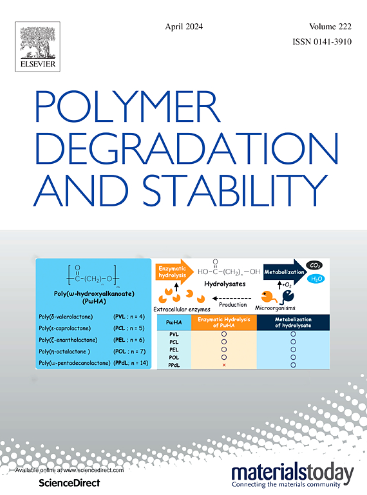Randomly methylated β-cyclodextrin as a modifier in PBAT/PLA-based films: Stability and crystallinity evaluation
IF 6.3
2区 化学
Q1 POLYMER SCIENCE
引用次数: 0
Abstract
The poly(butylene adipate-co-butylene terephthalate)/polylactide (PBAT/PLA) have attracted a great deal of attention in recent years due to their excellent (bio)degradability. In this study, the PBAT/PLA-based films with and without randomly methylated β-cyclodextrin (RM-β-CD) were prepared using solvent-casting and pressing techniques to evaluate the physiochemical and degradation properties of the obtained films. The characterisation of PBAT/PLA-based films was conducted by using microscopes (optical and AFM), GPC, DSC, and XRD measurements. In addition, degradation tests in water at 37 and 70 °C were conducted under abiotic conditions for 70 days. The research revealed that the addition of RM-β-CD resulted in shifts in the glass transition temperature and greater ordering of PBAT/PLA-based films as well as a slight decrease in cytocompatibility. However, antimicrobial activity and cytotoxicity studies performed did not reveal any risks for their possible applications. Analysis of the degradation progress showed that at 37 °C a slight molar mass loss for solvent-cast films and a slightly higher loss for solvent-cast films with RM-β-CD were noticed. No changes were observed in the more ordered pressed films. Hydrolytic degradation of all PBAT/PLA-based films during incubation at 70 °C resulted in a continuous decrease in the molar mass. Solvent-cast films are characterised by poor miscibility and phase separation, resulting in high roughness. However, the higher temperature during degradation and generally the addition of RM-β-CD to the polymer matrix improved their miscibility.
随机甲基化β-环糊精作为PBAT/ pla基薄膜的改性剂:稳定性和结晶度评价
聚己二酸丁二烯-对苯二甲酸丁二烯共酯/聚乳酸(PBAT/PLA)由于其优异的生物降解性近年来引起了广泛的关注。本研究采用溶剂铸造和压制技术制备了随机甲基化β-环糊精(RM-β-CD)和不随机甲基化β-环糊精(RM-β-CD)的PBAT/ pla基薄膜,并对薄膜的理化性能和降解性能进行了评价。通过显微镜(光学显微镜和原子力显微镜)、GPC、DSC和XRD测量对PBAT/ pla基薄膜进行了表征。此外,在37°C和70°C的非生物条件下进行了70天的水中降解试验。研究表明,RM-β-CD的加入导致PBAT/ pla基薄膜的玻璃化转变温度发生变化,有序度提高,细胞相容性略有下降。然而,抗菌活性和细胞毒性研究并未显示其可能应用的任何风险。对降解过程的分析表明,在37℃时,溶剂铸膜有轻微的摩尔质量损失,而含有RM-β-CD的溶剂铸膜的摩尔质量损失略高。在较有序的压膜中没有观察到变化。在70°C的孵育过程中,所有PBAT/ pla基薄膜的水解降解导致摩尔质量持续下降。溶剂铸膜的特点是混相性和相分离性差,导致粗糙度高。然而,降解过程中较高的温度和通常在聚合物基体中添加RM-β-CD可以改善它们的混溶性。
本文章由计算机程序翻译,如有差异,请以英文原文为准。
求助全文
约1分钟内获得全文
求助全文
来源期刊

Polymer Degradation and Stability
化学-高分子科学
CiteScore
10.10
自引率
10.20%
发文量
325
审稿时长
23 days
期刊介绍:
Polymer Degradation and Stability deals with the degradation reactions and their control which are a major preoccupation of practitioners of the many and diverse aspects of modern polymer technology.
Deteriorative reactions occur during processing, when polymers are subjected to heat, oxygen and mechanical stress, and during the useful life of the materials when oxygen and sunlight are the most important degradative agencies. In more specialised applications, degradation may be induced by high energy radiation, ozone, atmospheric pollutants, mechanical stress, biological action, hydrolysis and many other influences. The mechanisms of these reactions and stabilisation processes must be understood if the technology and application of polymers are to continue to advance. The reporting of investigations of this kind is therefore a major function of this journal.
However there are also new developments in polymer technology in which degradation processes find positive applications. For example, photodegradable plastics are now available, the recycling of polymeric products will become increasingly important, degradation and combustion studies are involved in the definition of the fire hazards which are associated with polymeric materials and the microelectronics industry is vitally dependent upon polymer degradation in the manufacture of its circuitry. Polymer properties may also be improved by processes like curing and grafting, the chemistry of which can be closely related to that which causes physical deterioration in other circumstances.
 求助内容:
求助内容: 应助结果提醒方式:
应助结果提醒方式:


